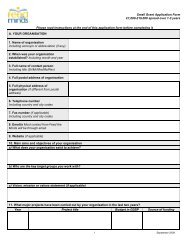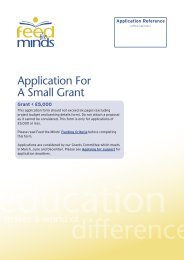Female Genital Mutilation practices in Kenya: - Feed the Minds
Female Genital Mutilation practices in Kenya: - Feed the Minds
Female Genital Mutilation practices in Kenya: - Feed the Minds
You also want an ePaper? Increase the reach of your titles
YUMPU automatically turns print PDFs into web optimized ePapers that Google loves.
12.<br />
birth at 19 years, nearly four years earlier than<br />
women <strong>in</strong> Nairobi (2009/2008 KDHS). However, <strong>the</strong><br />
region has shown steady improvement over <strong>the</strong><br />
past decade <strong>in</strong> girl child enrolment and retention<br />
<strong>in</strong> primary school; <strong>in</strong> 2002, 89% of all school-age<br />
girls <strong>in</strong> Nyanza were enrolled <strong>in</strong> primary school,<br />
<strong>in</strong>creas<strong>in</strong>g to 98% <strong>in</strong> 2008(MOE, 2009 ). Primary<br />
school completion rate for girls <strong>in</strong> 2008 <strong>in</strong> Nyanza<br />
was 72%, compar<strong>in</strong>g favourably to <strong>the</strong> national<br />
average for girls (75%), but lower than for boys <strong>in</strong><br />
<strong>the</strong> same prov<strong>in</strong>ce (85%).<br />
Despite <strong>the</strong>se positive <strong>in</strong>dicators, <strong>the</strong> Kisii (also<br />
known as <strong>the</strong> Abagusii) and Kuria communities<br />
have some of <strong>the</strong> highest levels of FGM <strong>in</strong> <strong>Kenya</strong>.<br />
The 2008/2009 KDHS established that 96% of<br />
women from <strong>the</strong> Kisii community have been<br />
circumcised. A study by Population Council<br />
<strong>in</strong> 2004 13 among <strong>the</strong> Kisii <strong>in</strong> Nyanza Prov<strong>in</strong>ce<br />
found that FGM is considered an important rite<br />
of passage from girl to a respected woman;<br />
a circumcised woman is considered mature,<br />
obedient and aware of her role <strong>in</strong> <strong>the</strong> family and <strong>in</strong><br />
<strong>the</strong> society, characteristics that are highly valued<br />
<strong>in</strong> <strong>the</strong> community. The need to control a woman’s<br />
sexual desire before marriage was reported to<br />
be ano<strong>the</strong>r reason for <strong>the</strong> practice, as well as <strong>the</strong><br />
perceived need to ensure fidelity, especially with<strong>in</strong><br />
polygamous marriages. FGM is also considered<br />
a cultural identifier among <strong>the</strong> Abagusii,<br />
dist<strong>in</strong>guish<strong>in</strong>g <strong>the</strong>ir daughters from neighbour<strong>in</strong>g<br />
communities who do not circumcise women. The<br />
2008/2009 KDHS found that <strong>the</strong> majority of girls <strong>in</strong><br />
Nyanza Prov<strong>in</strong>ce were undergo<strong>in</strong>g FGM aged 10-<br />
13 years, at <strong>the</strong> onset of puberty.<br />
Over time, changes <strong>in</strong> practice have been<br />
observed among <strong>the</strong> Kuria and Kisii. Among<br />
<strong>the</strong> Kisii, a <strong>the</strong>re has been a trend towards<br />
medicalisation, us<strong>in</strong>g medical staff to perform<br />
FGM. Population Council found that while 94% of<br />
circumcised mo<strong>the</strong>rs had been cut by a traditional<br />
circumciser, only 29% of circumcised girls aged 4<br />
– 17 years had been cut by a traditional<br />
13 Njue C, and Askew I (2004) Medicalization of <strong>Female</strong> <strong>Genital</strong><br />
Cutt<strong>in</strong>g among <strong>the</strong> Abagusii <strong>in</strong> Nyanza Prov<strong>in</strong>ce, <strong>Kenya</strong>.<br />
FRONTIERS, Population Council<br />
circumciser, and that <strong>the</strong> majority had been cut by<br />
a nurse or doctor. Among those cut by a medical<br />
practitioner, about half were cut at a health facility<br />
while <strong>the</strong> rest were cut at <strong>the</strong>ir own or ano<strong>the</strong>r<br />
home. Ano<strong>the</strong>r change that has been reported<br />
is decreas<strong>in</strong>g severity of <strong>the</strong> cutt<strong>in</strong>g, with a move<br />
towards prick<strong>in</strong>g <strong>the</strong> clitoris to draw blood, ra<strong>the</strong>r<br />
than cutt<strong>in</strong>g. Reports by GTZ <strong>in</strong> 2005 14 and 2007 8<br />
noted that <strong>the</strong> type of FGM <strong>in</strong> Kuria appeared<br />
to be chang<strong>in</strong>g to lesser forms. There was also<br />
a decrease found <strong>in</strong> <strong>the</strong> age at which girls were<br />
undergo<strong>in</strong>g FGM.<br />
In <strong>the</strong> last decade, <strong>in</strong> Kisii and Kuria a range of<br />
<strong>in</strong>terventions to discourage FGM have been<br />
implemented by local and <strong>in</strong>ternational NGOs<br />
and government agencies, <strong>in</strong>clud<strong>in</strong>g ARP,<br />
which has usually been part of a programme<br />
<strong>in</strong>volv<strong>in</strong>g community awareness rais<strong>in</strong>g, work<strong>in</strong>g<br />
with schools, health providers, religious and<br />
community leaders. MYWO and PATH were <strong>the</strong><br />
first to <strong>in</strong>corporate ARP <strong>in</strong>to <strong>the</strong>ir programmes <strong>in</strong><br />
<strong>the</strong> early 1990s, alongside public education and<br />
sensitization activities, although nei<strong>the</strong>r is lead<strong>in</strong>g<br />
on such programmes currently. However, despite<br />
<strong>the</strong> wide range of <strong>in</strong>terventions to encourage<br />
<strong>the</strong> abandonment of FGM <strong>in</strong> Kuria and Kisii, <strong>the</strong><br />
prevalence rema<strong>in</strong>s among <strong>the</strong> highest <strong>in</strong> <strong>Kenya</strong>.<br />
<strong>Feed</strong> <strong>the</strong> M<strong>in</strong>ds (FTM), UK, has been support<strong>in</strong>g<br />
two community-based NGOs, Reach Women and<br />
Youths Development Organization (RWAYDO), <strong>in</strong><br />
Kisii, and Education Centre for <strong>the</strong> Advancementof<br />
Women (ECAW) <strong>in</strong> Kuria, that have been<br />
undertak<strong>in</strong>g activities to combat FGM for several<br />
years. Both RWAYDO and ECAW have recently<br />
been <strong>in</strong>volved <strong>in</strong> support<strong>in</strong>g ARP events with<br />
reported success. The purpose of this report and<br />
study was to explore <strong>the</strong> ways, if any, <strong>in</strong> which ARPtype<br />
approaches can contribute to abandonment<br />
of FGM <strong>in</strong> Kisii and Kuria.<br />
14 GTZ (2005) <strong>Female</strong> <strong>Genital</strong> <strong>Mutilation</strong> <strong>in</strong> Kuria District: f<strong>in</strong>d<strong>in</strong>gs of a<br />
base l<strong>in</strong>e survey. GTZ / <strong>Kenya</strong> M<strong>in</strong>istry of Health




